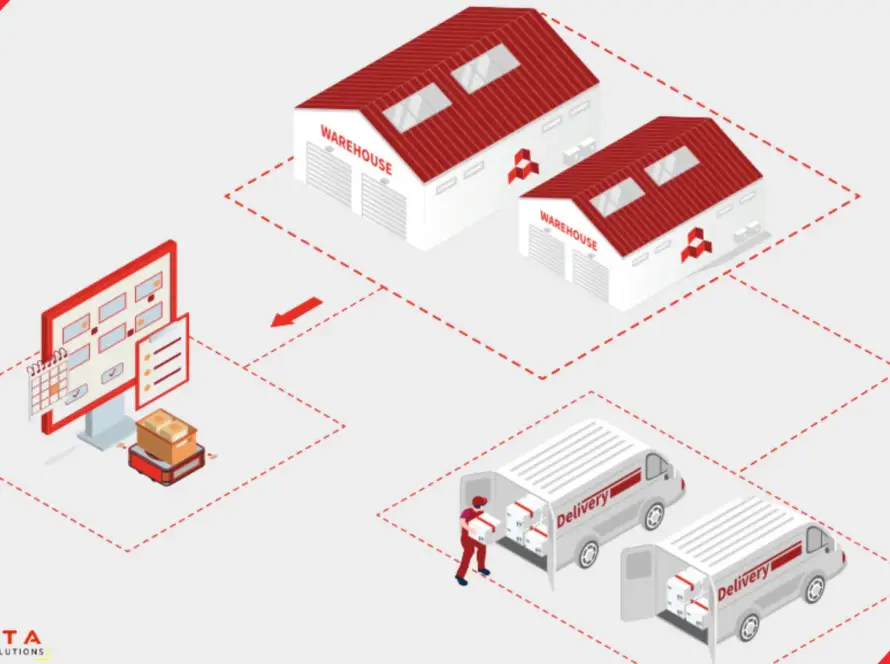E-commerce Inventory Management
It refers to the proper managing and overseeing of a business stock of products sold digitally via the Internet. It includes monitoring inventories, ordering stock, and guaranteeing that products are well stocked to meet customers’ demands. Stockouts and overstock are detrimental to businesses because they cause lost sales or unnecessarily increase the holding cost on inventory.
That is; demand forecasting and stock replenishment and the use of technology such as inventory management software. Since e-commerce has become increasingly popular, the control of inventory across various channels and applications has become essential for operational productivity, supply chain integrity, and customer satisfaction.

Importance of Inventory Management in E-commerce
Meeting consumer demands is a key goal of any e-commerce store, and inventory management is in the middle of this. This is important in delivery since orders are prepared and shipped as soon as the mentioned items are available in the store. Further, customers’ demand is immediate with high expectations on the product descriptions and stock availability. Lack of proper inventory can result in late shipment, the wrong product being shipped, or even worse, an order being canceled.
Through proper inventory management, a business will be able to satisfy the customers’ demands, gain their confidence, and hence retain them for the long run. With e-commerce businesses growing around the world, the challenges of inventory increase. This situation is challenging because, with the international markets, organizations are required to manage inventory in various countries, at other time zones, and in different legal frameworks. Inventory control in various locations involves tracking, analyzing, and planning for inventory in various locations, warehouses, distribution centers, and stores.
Also, there are challenges of import/export laws, transportation costs across borders, and time delays at the customs area. When it comes to companies growing their operations across borders, having an intelligent inventory management system is a necessity for positive enterprise outcomes and customer satisfaction on the international level.
Challenges in E-commerce Inventory Management
1. The Complexity of Managing Multiple Sales Channels
Managing inventory across several sales channels, such as e-commerce websites, and physical stores, adds complexity. Keeping inventory data synchronized across systems may be difficult, as integration issues frequently result in inconsistencies and mistakes, making inventory management inefficient.
2. Stockouts & Overstocking
Stockouts lead to lost revenue, consumer unhappiness, and harm to brand loyalty. Overstocking, on the other hand, locks up capital, raises storage expenses, and may necessitate the sale or discounting of extra inventory. Striking the appropriate balance between stockouts and overstocking is an ongoing issue for e-commerce enterprises looking to manage their inventories.
3. Demand Forecasting Difficulties
Demand forecasting can be challenging because of seasonal swings and unanticipated adjustments in customer preferences. Inadequate historical data frequently results in incorrect estimates, making companies subject to stockouts or overstocking.
4. Inventory Visibility and Transparency.
Tracking inventory across various warehouses or delivery sites may result in visibility gaps. Real-time visibility of stock levels is critical, but challenging to achieve. Managing client expectations about stock availability, particularly for high-demand commodities, adds an extra degree of complexity.
5. Manual Errors and Data Mismatches
Manual data input increases the possibility of mistakes, resulting in disparities between physical inventory and system records. Reconciling these inaccuracies necessitates periodic inspections and modifications, which consume significant time and resources.
6. Handling perishable and Fragile goods
E-commerce enterprises that deal with perishable or delicate items face extra hurdles, such as maintaining expiration dates and avoiding spoiling. Special storage, handling, and packaging requirements affect inventory management, especially in cold chain logistics for temperature-sensitive products.
7. Dead Stock and Product Obsolescence
Long storage periods cause money to be locked up in unsold products. Outdated or out-of-season items need strategic clearance, frequently via discounts or liquidation, complicating inventory management.
8. Returns Management and Reverse Logistics
Returns are a prevalent problem in e-commerce, and handling them properly is critical for inventory accuracy and profitability. A well-managed reverse logistics process ensures that returns are processed swiftly, stock levels are updated, and judgments are made about whether returned products should be replenished or written off.
Looking For E-Commerce Solutions! We are Just a Click Away
Control Measures for E-commerce Inventory Management
1. Centralized Inventory Management System
Implementing a consolidated inventory management system is critical for optimizing operations across numerous sales channels. Cloud-based technologies offer real-time updates, allowing businesses to manage inventory across many e-commerce sites, marketplaces, and physical storefronts.
This method guarantees that inventory data is consistent and correct, minimizing inconsistencies. Integration with ERP (Enterprise Resource Planning) systems improves data flow across departments like as accounting, order processing, and inventory, allowing for more effective stock management.
2. Real-Time Inventory Tracking and Automation
Implementing real-time inventory monitoring technology, such as barcode scanning or RFID, is critical for accurate and current inventory management. These systems guarantee that every product is traced throughout the supply chain, eliminating human error and inventory problems.
Furthermore, warehouse automation systems may initiate refilling orders when inventory reaches specified levels, ensuring that there is always adequate stock to fulfill demand. Automated systems also assist in eliminating mistakes by decreasing human involvement, resulting in more accurate inventory data.
3. Demand Forecasting Tools and Analytics
To minimize stockouts and overstocking, businesses must use advanced demand forecasting technologies. Artificial Intelligence and machine learning-powered solutions can analyze sales data, consumer behavior, and industry trends more correctly forecast demand.
E-commerce enterprises may use predictive analytics to proactively manage inventory, ensuring that items are available when required while not overinvesting in stock. These technologies help businesses plan ahead, eliminate waste, and adapt rapidly to changing market situations.
4. Regular Stock Audits and Replenishments
Regular stock audits are an important control tool for ensuring correct inventory records. Periodic cycle counts guarantee that inventory levels are updated and matched with physical stock, hence eliminating inconsistencies. Automated low-stock notifications play an important role in inventory replenishment since they tell firms when it is time to refill items before they run out, reducing the danger of stockouts.
Adopting a Just-In-Time (JIT) inventory system reduces surplus stock by relying on suppliers to supply items when needed, which optimizes working capital and storage expenses.
5. Warehouse Optimization and Inventory Allocation
Warehouse optimization is essential for effective inventory management. Incorporating smart warehouse technology, such as robots and AI systems, improves commodities storage and retrieval efficiency. These improvements decrease human error, increase storage efficiency, and boost overall productivity.
Dynamic inventory allocation distributes products among several warehouses depending on demand patterns and geographical areas, lowering transportation costs and delivery times. This method improves the speed and accuracy of order fulfillment, resulting in customer satisfaction.
6. Managing Deadstock Effectively
Deadstock may eat up important capital and warehouse space. Clearance sales are an effective management strategy in which businesses provide discounts to move slow-moving goods, therefore freeing up storage space and recovering some cash. In circumstances where the stock is outdated or unsellable, options such as donation or liquidation can assist prevent total losses.
Regular usage of inventory aging reports is critical for identifying goods that are approaching depreciation, allowing businesses to take proactive steps to minimize slow-moving stock before it becomes a major issue.
7. Adopting a Hybrid Model for Perishable Goods
Managing perishable items poses particular issues, such as maintaining product quality and preventing spoiling. The First In, First Out (FIFO) system guarantees that older products sell before fresh stock, reducing the danger of waste.
For organizations that deal with temperature-sensitive items, integrating real-time temperature and humidity monitoring systems helps guarantee that perishables are kept and delivered under ideal circumstances, preserving their quality and increasing shelf life.
8. Optimizing Return Management
Efficient returns handling is critical for keeping inventory accurate and customers satisfied. Automated methods streamline the return process, ensuring that returned items are processed and refilled fast. A well-organized inspection and restocking system assists in determining which returned products are resellable, allowing them to be rapidly brought back into inventory.
Businesses must have clear rules in place for disposing of unsellable products, liquidating them, or recycling them, so that returns do not impair overall inventory accuracy and profitability.
Solutions for E-commerce Inventory Management
1. Cloud-Based Inventory Management Software
Cloud-based inventory management software is a game changer for e-commerce enterprises, providing scalability, accessibility, and seamless integration across several platforms. These cloud solutions offer real-time information, allowing businesses to track stock levels, order fulfillment, and overall performance regardless of location.
Cloud-based solutions are flexible enough to manage increased order quantities, allowing organizations to scale easily while retaining operational efficiency.
2. Third-Party Logistics (TPL) Integration
Outsourcing fulfillment to a Third-Party Logistics (3PL) provider has considerable benefits for e-commerce companies aiming to improve inventory management. Businesses that engage with a 3PL supplier may focus on core activities such as marketing and product development while outsourcing warehousing, picking, packing, and shipping services.
This collaboration decreases fulfillment complexity, particularly for companies expanding into new areas or foreign markets. 3PL suppliers already have the infrastructure in place to efficiently manage inventories, give global access, and minimize shipment times. Furthermore, 3PL services frequently interface with e-commerce systems, ensuring that inventory data is synced, reducing mistakes, and increasing overall efficiency.
3. Inventory Control Techniques (Just-in-Time and Drop Shipping)
Inventory control solutions such as Just-in-Time (JIT) and drop shipment assist e-commerce enterprises in optimizing their stock management. The JIT strategy lowers holding costs and increases cash flow by ordering products only when it is required, reducing the need to maintain surplus inventory. This method guarantees that organizations do not overinvest in inventory while still satisfying client demand.
Drop shipping provides an additional benefit by allowing businesses to fulfill orders straight from suppliers, eliminating the need to keep inventory. This strategy decreases inventory risk because businesses do not have to deal with unsold goods or warehouse management, making it an appealing choice for those with limited storage capacity.
4. Omnichannel Integration
Omni-channel integration enables businesses to manage inventories on many platforms, including physical stores, online stores, and third-party markets. Unified inventory management solutions enable businesses to track and update stock levels in real-time, lowering the risk of stockouts and overstocking. With an integrated system, businesses can fulfill orders from any location, whether it’s a warehouse, retail shop, or 3PL partner, assuring order flexibility.
This connection ensures a uniform consumer experience across all sales channels and allows businesses to manage inventory more efficiently, synchronizing stock levels and fulfilling orders quickly.
5. Artificial intelligence (AI) and predictive analytics
Artificial intelligence (AI) and machine learning algorithms are rapidly being utilized in e-commerce inventory management to forecast demand, automate reorder points, and improve warehouse efficiency. By evaluating previous sales data and customer behavior, AI can forecast which items are likely to be in demand, allowing businesses to plan ahead.
AI-powered systems may automatically restock items when stock levels reach specified levels, decreasing the risk of stockouts and guaranteeing that products are available when customers want them. Predictive analytics may also assist organizations manage warehouse operations by spotting patterns in product demand and improving inventory allocation, resulting in lower storage costs and more operational efficiency.

Conclusion
Effective e-commerce inventory management is critical for organizations seeking to satisfy consumer needs, maintain operational efficiency, and avoid costly concerns such as stockouts and overstocking. Using modern solutions like cloud-based software, 3PL integration, and AI-driven predictive analytics may help businesses optimize stock control, improve fulfillment centers, and increase customer satisfaction.
Furthermore, initiatives such as Just-in-Time inventory, omnichannel integration, and demand forecasting allow businesses to remain competitive while effectively managing resources. As e-commerce expands, implementing these solutions guarantees that businesses can scale, simplify operations, and provide superior service, preparing them for long-term success in the dynamic online marketplace.
Thanks For Reading: E-commerce Inventory Management: Challenges, Control & Solutions
Powered By 360Presence

